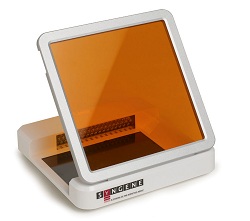SYNGENE says its new UltraSlim-LED blue light transilluminator provides safer excitation of fluorescent dyes than conventional UV, with comparable results. UltraSlim-LED, as its name suggests, uses LEDs which produce ‘Epi-blue’ light with a narrow emission peak centred at 470nm. This, says the company, provides sensitive yet safe viewing of many fluorescently stained DNA and RNA gels.
Dyes which are effectively excited by the new illuminator include ethidium bromide, GelRed, GelGreen, SYBR Gold, SYBR Green, SYBRSafe, and Syngene’s own new UltraPower DNA safe dye.
The device offers two main benefits, says Syngene: being of slim design, it requires little space on the lab bench and is easy to relocate. The use of safe LEDs means that scientists need not worry about stray UV radiation, which could cause damage to retina or skin. It is also compatible with any Syngene gel documentation system, allowing users to produce high quality images for publication or analysis.
It’s perhaps worth noting that LED light causes less damage to the DNA in the gel, so that this may be extracted for cloning even after long exposure times. The company’s divisional manager, Laura Sullivan, observed: “Isolating DNA is one of the basic things molecular biologists do regularly, and the UltraSlim-LED illuminator offers a way of safely viewing stained gels, either on the lab bench or inside a gel doc system. Using high-intensity blue light eliminates the dangers of UV, does not damage DNA fragments, and yet illuminates even the faintest of bands”.
An integral hood and camera housing for the UltraSlim-LED is currently listed as ‘coming soon’ on the Syngene website.

